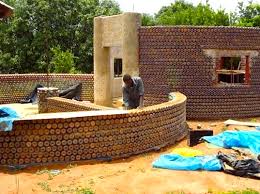In Nigeria, an innovative solution to both housing shortages and plastic pollution is reshaping the concept of affordable living. Known as plastic bottle houses, these structures use discarded plastic bottles filled with sand or soil as building blocks. The result is a low-cost, eco-friendly, and surprisingly durable alternative to traditional brick-and-cement homes.
This approach not only addresses the country’s growing waste management issues but also offers an affordable housing model for low-income communities.
What Are Plastic Bottle Houses?
Plastic bottle houses, often called bottle-brick homes, use recycled plastic bottles as primary building materials. The bottles are tightly filled with sand to create compact, durable “bricks” that are bound together with cement or clay mortar.
Each house requires thousands of bottles one project in Kaduna, Nigeria, used over 14,000 bottles to build a three-room house. The sand-filled bottles provide excellent structural integrity and insulation, making them ideal for the hot Nigerian climate.
Why Use Plastic Bottles for Building?
1. Environmental Benefits
- Reuses plastic waste that would otherwise pollute the environment.
- Reduces landfill accumulation and plastic pollution in waterways.
- Encourages recycling and environmental awareness within communities.
2. Economic and Social Advantages
- Reduces construction costs compared to using cement blocks or bricks.
- Provides employment and training for local workers in sustainable building techniques.
- Promotes community participation and education on environmental responsibility.
3. Strength and Durability
When properly constructed, sand-filled plastic bottles create strong, shock-absorbent walls. Some tests have shown that bottle-brick houses can withstand seismic vibrations and provide thermal insulation, keeping interiors cooler in hot climates.
Case Studies in Nigeria
Kaduna Plastic Bottle House
In Kaduna State, engineer Yahaya Ahmed built a three-bedroom house using approximately 14,800 plastic bottles filled with sand. The structure included a kitchen, living area, and toilet facilities. Ahmed’s project aimed to showcase how waste materials could be reused to solve both environmental and housing challenges.
The project has drawn attention from sustainability advocates and government agencies interested in green building alternatives.
Ogun State and Community Projects
In Ogun State, research institutions and non-governmental organizations have conducted similar experiments using recycled plastic bottles as housing material. Their studies show that bottle houses can significantly reduce construction costs while promoting sustainable waste management.
How Plastic Bottle Houses Are Built
The construction process for a bottle house follows several key steps:
- Collection: Gather large quantities of used plastic bottles (typically PET bottles).
- Filling: Fill each bottle tightly with sand, soil, or small stones for weight and stability.
- Placement: Align the bottles horizontally and stack them in rows, just like bricks.
- Binding: Use mud, cement, or mortar to hold the bottles together and strengthen the wall.
- Finishing: Plaster the walls for a smooth surface and add roofing, doors, and windows as in standard houses.
This process is labor-intensive but can be completed using locally available materials and manpower, making it suitable for rural or community-based construction projects.

Benefits of Plastic Bottle Houses
- Affordable Construction: Reduces dependency on expensive materials like cement blocks.
- Waste Reduction: Helps manage Nigeria’s growing plastic waste problem.
- Thermal Efficiency: Maintains comfortable indoor temperatures even in hot weather.
- Durability: Properly built bottle houses can last for decades with minimal maintenance.
- Job Creation: Provides employment opportunities through bottle collection and construction.
Challenges and Limitations
While promising, the plastic bottle housing model faces several challenges:
- Building Code Acceptance: Nigerian building standards have yet to fully recognize bottle-brick construction.
- Labor Requirements: Collecting and filling thousands of bottles is time-consuming.
- Public Awareness: Many communities are still unaware of this technique’s potential.
- Quality Control: Inconsistent filling or weak binding materials can compromise structural integrity.
Despite these challenges, continued research, training, and policy support could help scale the model for broader adoption.
Why This Matters for Nigeria
Nigeria faces a dual crisis: a housing deficit affecting millions and an ever-growing plastic waste problem. Plastic bottle houses present a solution that addresses both issues simultaneously.
By turning discarded bottles into building materials, these projects reduce environmental impact while creating affordable housing for low-income families. They also encourage innovation, sustainability, and community development key pillars for a greener future.
Global Context and Inspiration
The idea of building with bottles is not unique to Nigeria. Similar projects have been implemented in countries like India, Honduras, and Tanzania. However, Nigeria’s rapid urbanization and waste challenges make it an ideal place to adopt and scale this approach.
As environmental awareness grows and construction costs continue to rise, bottle-brick architecture could become a vital part of sustainable development across Africa.
Conclusion
Plastic bottle houses in Nigeria symbolize innovation through necessity. They transform everyday waste into strong, affordable homes while promoting environmental responsibility and social empowerment.
Though challenges remain in regulation and scalability, these houses offer a glimpse into a sustainable future where waste becomes a resource and architecture becomes a tool for change.
By combining creativity, sustainability, and community involvement, Nigeria’s bottle house movement proves that solving environmental and social issues can go hand in hand one plastic bottle at a time.





